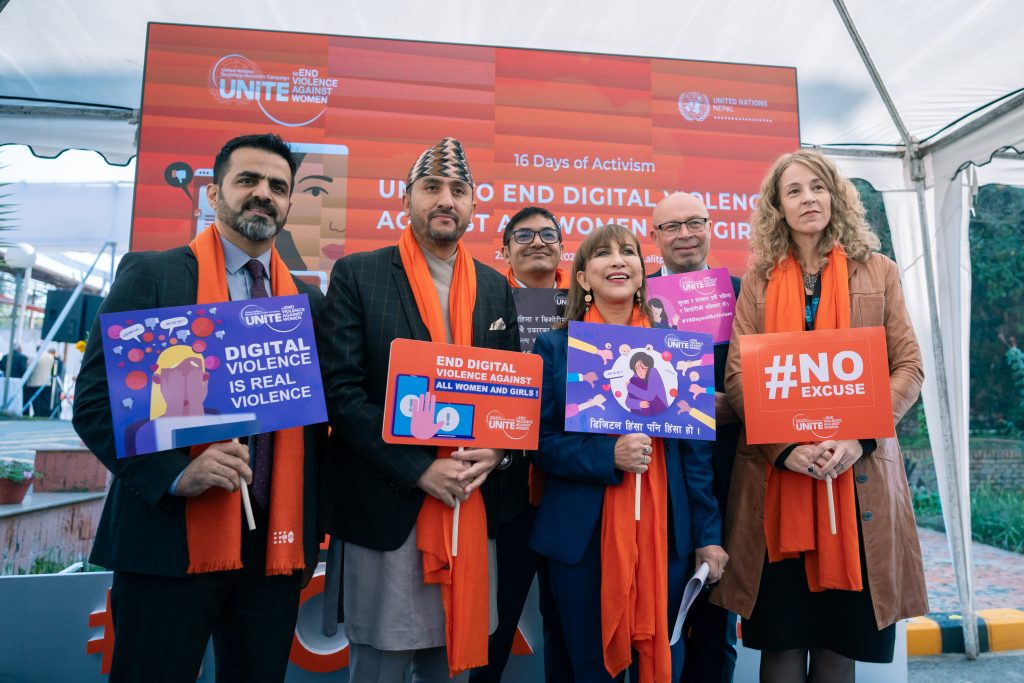
We gather today with a simple truth: violence against women is not new—no, but the ways such violence are carried out are changing. Changing at a speed we can barely keep up with.
Just imagine Mahima in Myagdi waking up to a message from a stranger who somehow knows the exact route she takes to work. Likewise, Sarina in Sarlahi discovered her teenage daughter’s face—her identity—digitally stitched onto explicit images, into deep fake videos, and circulated across the internet.
Now, imagine yourself, being silenced, taunted, stalked, humiliated, or threatened not in a dark street, but in your own bedroom, through the screen in front of you, or in the palm of your hands.
For millions of women and girls around the world, and increasingly here in Nepal, these are not imaginations. They are daily realities.

Yes, technology has connected us in extraordinary ways, but it has also become a weapon—a weapon used to stalk, to shame, to silence, and to control women and girls from every corner of society.
This is the new frontline of gender-based violence, one that is alarmingly emboldened every day with artificial intelligence. And if we are honest with ourselves—we are not yet winning this fight. Digital abuse is a global phenomenon. In some regions nearly 60% of the women have reported facing some form of digital abuse.
Girls—especially teenage girls—are among the most targeted. Women with disabilities, women of colour, indigenous women, LGBTIQ+ persons, migrant women, or wives of migrant workers—those who already face discrimination offline—are attacked with even greater ferocity online.
Women in public life—journalists, activists, politicians—pay a heavy price for simply speaking. 73% of women journalists face digital violence. And one in three women parliamentarians in Asia Pacific has been attacked digitally for daring to lead. This is not just “online drama” or “trolling.” This is digital violence— with devastating psychological, reputational, social, economic, and sometimes physical consequences.
Because what happens online does not stay online. Doxing leads to stalking. Sextortion leads to self-harm. Deepfakes lead to job loss, public shaming, and lifelong trauma. Hate speech leads to real-world threats. Digital manipulation leads to control—of movement, of autonomy, of voice. And slowly, quietly, suffocatingly— women disappear. From public spaces. From leadership. From opportunities. From conversations. From visibility. From safety. And here in Nepal, the picture is just as alarming. Nepal’s digital transformation is moving fast—16.5 million people here are online, more than 56% of the population. This heightened connectivity brings opportunity, yes, but also new and dangerous vulnerabilities. Just last year, the Cyber Bureau of Nepal Police registered 18,926 cybercrime cases—an average of 52 cases every single day!!
Among these: 7,921 complaints were filed by women, 1,801 cases involved bullying or harassment, 495 were hate speech incidents, 84 were sextortion cases and 27 involved image morphing or deepfake-style abuse. These numbers are not statistics – there is a face behind each of these cases. The scenario is also grim in terms of scale and severity amongst youngsters whose online presence grew significantly during COVID lockdown. In the past two years cyber abuse cases involving children rose sharply from 176 cases 706.

While the internet offers children with enhanced learning opportunities and creative expression, it also presents significant dangers, including exposure to inappropriate content, cyber-bullying, online predators and privacy breaches. Lack of awareness about these risks amongst parents and guardians, and the growing trend of screens being used as babysitting tools, further exacerbate the situation.
Digital violence is a worldwide scourge that needs to be tackled on a global scale. And as warned by the UN Secretary-General’s 2024 report, such tech-facilitated violence is being exacerbated by three fast-growing dangers, namely: an intensifying backlash against women’s rights, the rapid rise of artificial intelligence, and the expanding manosphere—a global ecosystem of misogyny shaping how boys and men see, treat, and value women.
Every day, these forces amplify each other. Every day, they normalize harm. So, we cannot—must not—be bystanders because ending digital violence is not a “women’s issue.” It is a societal responsibility and a human rights imperative. We need: stronger laws and smarter policies across the board — legislative, administrative, infrastructural, technological and human resources. They should be designed with survivors, guided by evidence, aligned with global standards, and enforced with zero tolerance.
We need tech companies that take responsibility—not just make profit and shelter behind algorithms. We need better gender-disaggregated data, better definitions, better detection, tracking and public reporting because what we cannot measure, we cannot fix. We also need to inculcate digital citizenship in every school so that boys and girls learn not just how to use technology, but how to respect each other through it. We need more women and girls designing and leading the tech future to ensure that the tools are safe, shorn of biases.
We need to transform harmful social norms by challenging misogyny wherever we see it—in cybersphere, in public spaces, in political speeches, in homes, and in institutions.
And finally, we need a whole-of-society movement. We in the UN, all tiers of Government, the private sector, teachers, caregivers, journalists, youth leaders, civil society, and every bystander —all of us—must build a global firewall of solidarity around women and girls and refuse to let violence hide behind a screen. So, Let us be the generation that did not look away, but acted. We can. Remember that song from yesteryears: “hat-nay hoi-na, dati lad-nay , nepali ko baani hun-chha”,
So, Beyond these 16 days, let us act, speak, disrupt, and refuse to normalize abuse as “the cost of being online.” Because every girl and woman has the right to fearlessly live, lead, and thrive—online and offline. And every society has the responsibility to make this a reality.
(The article is an edited version of the speech delivered by the UN Resident Coordinator for Nepal, Hanaa Singer-Hamdy, during the ‘Launch of UNiTE 2025: Together to End Digital Violence Against Women and Girls’ on November 25, 2025.)